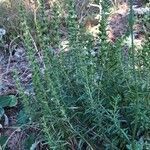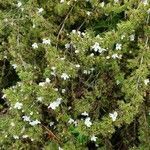An annual herb which grows from seed each year. It grows to 30 cm high and spreads to 25 cm wide. It has small narrow greyish green leaves. They are about 1.3 cm long. These turn slightly purple during summer and autumn. The leaves are attached directly to a pinkish stem. The flowers are small and white. They are in spikes in rings.









